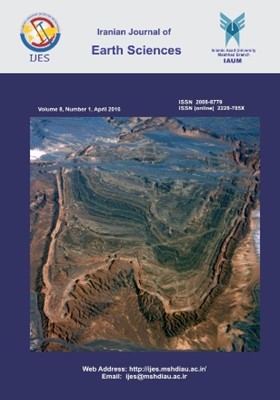Distribution and geochemical variations among paleogene volcanic rocks from the north-central Lut block, eastern Iran
Subject Areas : MineralogySaeed Saadat 1 , Charles Stern 2
1 - Department of Geology, Mashhad Branch, Islamic Azad University, Mashhad, Iran
2 - Department of Geological Sciences, University of Colorado, Boulder, CO, USA
Keywords: subduction, Lut block, basalts, volcanism, Eastern Iran,
Abstract :
The Lut block in eastern Iran is a micro-continental block within the convergent orogen between the Arabian, Eurasian and Indian plates. Large areas of the north-central, eastern, and western Lut block are covered by volcanic rocks of Paleogene, Neogene and Quaternary age. Peak volcanic activity took place in the north-central part of the Lut block during the Eocene, and then dramatically decreased, becoming more restricted to the eastern and western margins of the block during the late Miocene and Quaternary. There is also significant variation in chemistry between the Paleogene igneous rocks from the north-central part compared to the Neogene and Quaternary volcanic rocks from the western and eastern margins of the Lut block. The Neogene and Quaternary olivine basalts, which were erupted along both margins of the Lut block, are similar in trace element chemistry to the average composition of oceanic island basalt. In contrast, the Paleogene volcanic units of the north-central Lut block, which include basalts through rhyolites, follow both calc-alkaline and alkaline trends. Low TiO2 and high Ba/Nb and La/Nb ratios for both Paleogene basalts and andesitic samples from the north-central Lut block suggest affinities, at least for some of these samples, with convergent plate boundary arc magmas. LILE/HFSE ratios, interpreted as an indication of subduction signature, increase to the south-southwest of the central Lut block, where Neotethys oceanic crust was subducted beneath Iran in a northeastern direction from approximately Late Triassic to Late Oligocene time. We suggest that components derived from low angle subduction of this crust during the Mesozoic and early Tertiary were stored in the mantle lithosphere below the north-central Lut block until the Paleogene, when changing subduction geometry, associated with the collision of Arabia with Iran and the closing of Neotethys, caused hot asthenosphere to well up under the Lut block. This created the Eocene peak in volcanic activity, generating basalts from asthenospheric mixed with lithospheric melts, with both alkaline and calc-alkaline affinities. After this volcanism waned, becoming restricted during the Neogene to OIB-type alkaline basalts erupted through deep lithospheric structures along both the western and eastern margins of the Lut block.


